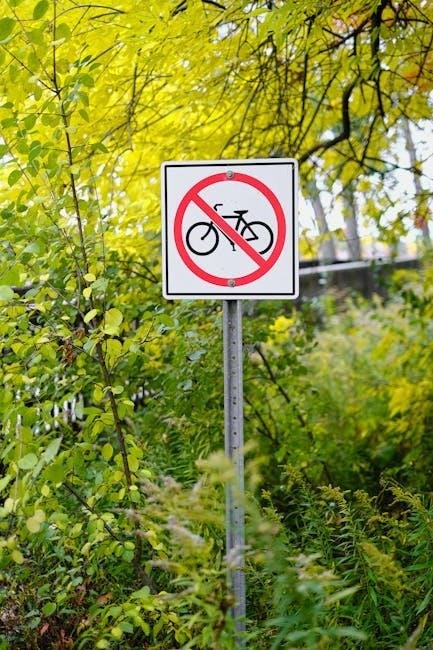The Building Safety Act 2022 is a landmark legislation introduced to enhance safety standards in higher-risk buildings across England and Wales, addressing critical gaps highlighted by the Grenfell Tower tragedy. It establishes a robust regulatory framework, ensuring accountability and transparency through measures like the “Golden Thread” of building safety information.
Background and Purpose of the Act
The Building Safety Act 2022 was enacted in response to the Grenfell Tower tragedy, addressing systemic failures in building safety. It introduces a new regulatory framework to protect residents and ensure accountability. The Act focuses on improving safety standards, enhancing oversight, and fostering a culture of safety in the construction industry. It represents a significant shift in building safety management, aiming to prevent future tragedies and ensure safer living environments.
Key Objectives of the Building Safety Act 2022
The primary objectives of the Building Safety Act 2022 are to enhance safety in higher-risk buildings, strengthen regulatory oversight, and ensure accountability. It aims to implement a proactive approach to building safety through the “Golden Thread” of information, providing clear responsibilities for dutyholders. The Act also seeks to restore public confidence by ensuring that safety is prioritized throughout a building’s lifecycle, from design to occupation. These measures collectively aim to prevent future tragedies and create a safer built environment for residents.
Historical Context and Triggers for the Act
The Grenfell Tower tragedy in 2017 exposed critical flaws in building safety regulations, prompting widespread calls for reform. This event, coupled with Dame Judith Hackitt’s independent review, catalyzed the Act’s creation.
The Grenfell Tower Tragedy and Its Impact
The Grenfell Tower fire in 2017 was a devastating event that claimed 72 lives, revealing systemic failures in building safety and regulation. The tragedy exposed inadequate fire safety measures, flawed regulatory frameworks, and insufficient oversight of high-rise buildings. It led to widespread public outrage and demands for accountability, prompting the UK Government to initiate a comprehensive review of building safety practices. Dame Judith Hackitt’s subsequent report highlighted the need for a fundamental overhaul of the regulatory system, directly influencing the drafting of the Building Safety Act 2022. The Grenfell tragedy remains a catalyst for the Act’s implementation, ensuring safer living conditions and preventing future disasters.
Independent Review of Building Regulations by Dame Judith Hackitt
Following the Grenfell tragedy, Dame Judith Hackitt led an independent review of UK building regulations, identifying significant systemic failures. Her report emphasized the need for a culture change, shifting from a compliance-based approach to one focused on accountability and safety outcomes; Hackitt highlighted the lack of clarity in responsibilities and the absence of a robust regulatory framework. Her recommendations formed the foundation of the Building Safety Act 2022, introducing concepts like the “Golden Thread” of building safety information and stricter accountability measures to ensure safer buildings for residents.

Key Reforms Introduced by the Act
The Building Safety Act 2022 introduces significant reforms, including a strengthened regulatory regime for higher-risk buildings, the “Golden Thread” of safety information, and enhanced accountability measures.
Strengthening the Regulatory Regime for Higher-Risk Buildings
The Building Safety Act 2022 introduces a stricter regulatory framework for higher-risk buildings, ensuring enhanced safety measures and compliance. This includes mandatory registration and regular assessments of high-rise structures. Building owners and managers must now adhere to more stringent safety standards, with a focus on fire safety and structural integrity; The Act also empowers regulators to enforce these standards more effectively, providing stronger oversight and accountability. These reforms aim to prevent tragedies like the Grenfell Tower fire and ensure safer living environments for residents. The new regime emphasizes proactive risk management and continuous improvement.
The Building Safety Act 2022 mandates the creation and maintenance of a “Golden Thread” of building safety information, ensuring a clear, comprehensive, and accessible record of a building’s safety details throughout its lifecycle. This digital or physical information thread includes design specifications, materials used, and ongoing safety measures. It aims to improve transparency, accountability, and compliance, enabling better decision-making by dutyholders and regulators. The Golden Thread ensures that critical safety information is preserved and updated, supporting the safe construction, maintenance, and occupation of higher-risk buildings. This requirement is central to achieving the Act’s goal of enhanced building safety standards.
Enhanced Accountability for Developers, Owners, and Contractors
The Building Safety Act 2022 imposes stricter accountability measures on developers, building owners, and contractors, ensuring they take direct responsibility for safety issues. Developers are now obligated to address historical defects in buildings they have constructed, while owners and landlords must maintain safety standards throughout a building’s lifecycle. Contractors are required to comply with new regulatory standards, and failure to do so may result in penalties. The Act also introduces the Building Safety Levy, funded by developers, to support safety improvements. These measures aim to create a culture of accountability and ensure safer living environments for residents. Regulatory bodies enforce these requirements rigorously.
Responsibilities of Key Actors Under the Act
The Building Safety Act 2022 assigns clear responsibilities to developers, building owners, and contractors, ensuring they maintain safety standards, contribute to the Golden Thread of information, and adhere to new regulatory requirements.
Duties of Developers and Building Owners
Under the Building Safety Act 2022, developers and building owners are required to ensure the safety of higher-risk buildings throughout their lifecycle. They must maintain detailed safety records as part of the “Golden Thread” of information, which ensures transparency and accountability. Additionally, they are responsible for identifying and addressing potential risks, complying with new regulatory standards, and contributing to the costs of rectifying historical building defects. The Act also introduces the Building Safety Levy, which requires developers to fund safety improvements. Failure to meet these obligations can result in enforcement action and penalties. This ensures a proactive approach to building safety.
Role of Contractors in Ensuring Compliance
Contractors play a pivotal role in ensuring compliance with the Building Safety Act 2022. They are responsible for adhering to new regulatory standards and maintaining safety throughout the construction process. This includes ensuring that materials and practices meet updated safety requirements. Contractors must also contribute to the development and maintenance of the “Golden Thread” of building safety information, which ensures transparency and accountability. Failure to comply can result in enforcement action, highlighting the importance of their role in upholding the Act’s objectives. Their collaboration with developers and owners is essential for achieving safer buildings.
Responsibilities of Regulators and Enforcement Bodies
Regulators and enforcement bodies under the Building Safety Act 2022 are tasked with ensuring compliance and upholding safety standards in higher-risk buildings. They conduct regular inspections, enforce safety requirements, and manage the “Golden Thread” of building safety information. These bodies have the authority to impose penalties for non-compliance and ensure that dutyholders meet their obligations. Their role is critical in maintaining public trust and ensuring that safety measures are consistently applied across the built environment. Their oversight is essential to preventing future tragedies and fostering a culture of accountability.

Enforcement and Compliance Mechanisms
Enforcement and Compliance Mechanisms
The Building Safety Act 2022 introduces robust enforcement mechanisms, including sanctions and penalties for non-compliance, ensuring accountability and adherence to safety standards in higher-risk buildings.
Sanctions and Penalties for Non-Compliance
The Building Safety Act 2022 imposes stringent sanctions and penalties for non-compliance, ensuring accountability. Criminal liability applies to dutyholders failing to meet safety standards, with significant fines.
Repeat offenses may result in substantial financial penalties, reflecting the severity of risks posed to residents. The Act also introduces measures to recover costs associated with remedying defects. These enforcement mechanisms aim to deter negligence and ensure adherence to safety regulations, fostering a culture of accountability across the construction and property management sectors. The penalties underscore the government’s commitment to safeguarding building safety and protecting occupants.
Inspection and Enforcement Powers of Regulatory Authorities
Under the Building Safety Act 2022, regulatory authorities are granted enhanced inspection and enforcement powers to ensure compliance with safety standards. These powers include the ability to conduct thorough inspections of higher-risk buildings, review safety documentation, and enforce corrective actions. Authorities can issue improvement notices and prosecute non-compliant dutyholders, with penalties reflecting the severity of violations. This robust enforcement framework ensures that safety standards are upheld, and accountability is maintained throughout the building lifecycle. The Act emphasizes proactive monitoring to prevent risks and protect occupants, reinforcing the government’s commitment to building safety. Regulatory oversight is central to achieving these goals.
Financial Provisions and Costs Associated with the Act
The Building Safety Act 2022 introduces a Building Safety Levy to fund safety measures, with costs primarily borne by developers and building owners, ensuring financial accountability.
Cost-Benefit Analysis of Implementing the Act
The Building Safety Act 2022 requires a detailed cost-benefit analysis to ensure that safety measures are proportionate and effective. This involves assessing the financial burden on developers, building owners, and the public sector against the long-term benefits of enhanced safety. The analysis considers upfront costs for compliance, ongoing maintenance expenses, and potential savings from reduced incidents and liabilities. Additionally, it evaluates the broader economic impacts, such as increased consumer confidence and property values, ensuring a balanced approach to implementing safety reforms. This process is crucial for justifying the regulatory changes and securing stakeholder buy-in.
Building Safety Levy and Its Implications
The Building Safety Levy is a key financial measure introduced under the Building Safety Act 2022, set to commence in autumn 2026; It will be paid by developers on new eligible residential buildings in England, contributing to the costs of remediating historical building defects. This levy aims to ensure that those responsible for building defects share the financial burden, while also providing protections for leaseholders. The levy’s implementation is expected to increase transparency and accountability in the construction industry, balancing the financial responsibilities of developers with the need to maintain building safety standards. Its implications extend to higher-risk buildings, ensuring long-term safety and compliance.

Impact on the Construction and Built Environment Industry
The Building Safety Act 2022 introduces significant reforms to building regulations, enhancing safety standards and accountability for developers, contractors, and building owners, ensuring transparency in the construction industry.
Changes in Construction Products Regulatory Regime
The Building Safety Act 2022 introduces stricter regulations for construction products, ensuring they meet enhanced safety standards. It grants the Secretary of State powers to enforce compliance, amend existing regulations, and address product safety concerns. This reform aims to prevent the use of defective materials, a critical issue highlighted by previous tragedies. The Act also imposes penalties for non-compliance, incentivizing manufacturers to adhere to new requirements; These changes align with the broader goal of improving building safety and protecting residents. The regulatory overhaul is complemented by the Building Safety Levy, which funds safety improvements across higher-risk buildings.
Effect on High-Rise and Higher-Risk Buildings
The Building Safety Act 2022 significantly impacts high-rise and higher-risk buildings by introducing stricter safety measures and regulatory oversight. Developers and building owners are now required to maintain detailed safety information, contributing to the “Golden Thread” of building safety. The Act mandates regular safety audits and inspections to ensure compliance with updated standards. Non-compliance penalties incentivize adherence to these new regulations. This focus on higher-risk buildings aims to prevent tragedies like Grenfell, ensuring safer living conditions for residents. The Act’s provisions are particularly stringent for high-rise structures, reflecting their increased risk profile and the need for enhanced accountability.

Secondary Legislation and Supporting Documents
The Building (Higher-Risk Buildings) Procedures Regulations 2023 and related guidance documents provide detailed frameworks for compliance, supported by official PDF resources and legislative summaries.
Building (Higher-Risk Buildings) Procedures Regulations 2023
The Building (Higher-Risk Buildings) Procedures Regulations 2023 (SI 2023/909) outlines mandatory procedures for dutyholders, ensuring compliance with the Building Safety Act 2022. It focuses on higher-risk buildings, detailing requirements for safety during design, construction, and occupation. The regulations emphasize the “Golden Thread” of information, maintaining accurate records to enhance accountability. They also establish clear processes for managing risks and ensuring ongoing safety. These procedures align with the Act’s broader objectives, aiming to prevent future tragedies by strengthening regulatory oversight and ensuring transparency in building safety practices.
Guidance on Secondary Legislation and Compliance
The UK Government has published comprehensive guidance to support compliance with the Building Safety Act 2022 and its secondary legislation. These documents provide detailed explanations of the new regulatory requirements, ensuring clarity for dutyholders, developers, and building owners. The guidance covers key aspects such as the “Golden Thread” of information, risk management, and procedural steps for higher-risk buildings. It also outlines the roles and responsibilities of stakeholders, offering practical advice to meet compliance standards. This resource is essential for navigating the complex regulatory landscape and ensuring adherence to the Act’s provisions effectively.
Publications and Resources Related to the Act
The UK Government has released official guidance documents and PDF summaries to help stakeholders understand and comply with the Building Safety Act 2022. These resources provide detailed insights and practical advice for developers, building owners, and contractors.
Official Government Guidance and Summaries
The UK Government has published comprehensive official guidance documents and PDF summaries to support the implementation of the Building Safety Act 2022. These resources provide detailed explanations of the Act’s provisions, including the “golden thread” of building safety information, compliance requirements, and the responsibilities of developers, owners, and contractors. The documents are designed to help stakeholders navigate the regulatory changes and ensure adherence to the new safety standards. They are available on the GOV.UK website, offering a centralized source of information for industry professionals, regulators, and the public. These materials are regularly updated to reflect the latest developments and enforcement guidelines.
PDF Resources and Legislative Documents
The Building Safety Act 2022 is supported by a range of PDF resources and legislative documents, ensuring clarity and accessibility for stakeholders. These include the full text of the Act, available as ukpga_20220030_en.pdf on the UK legislation website, as well as supplementary guidelines and summaries. Additionally, secondary legislation such as the Building (Higher-Risk Buildings) Procedures Regulations 2023 is provided in PDF format, offering detailed operational frameworks. These documents are essential for understanding compliance requirements, enforcement mechanisms, and the broader regulatory landscape, making them indispensable for professionals and organizations impacted by the Act. Regular updates ensure alignment with evolving safety standards and implementation phases.
Timeline and Implementation Phases
The Building Safety Act 2022 received Royal Assent on 28 April 2022, with key implementation phases completed by 6 April 2024, and further measures planned for 2026.
Key Dates and Milestones in the Act’s Implementation
The Building Safety Act 2022 received Royal Assent on 28 April 2022, marking a significant step in its implementation. The Act was first introduced as a Bill to Parliament on 5 July 2021. Key milestones include the 17 August 2023 publication of secondary legislation and the closure of the transitional period on 6 April 2024, after which the Act became fully enforceable. Additionally, the Building Safety Levy is set to be introduced in autumn 2026, further solidifying the Act’s regulatory framework. These dates underscore the phased approach to ensuring compliance and improving building safety standards.
The Building Safety Act 2022 included a transitional period to allow stakeholders to adapt to new requirements. This period concluded on 6 April 2024, after which the Act became fully enforceable. The transition aimed to provide adequate time for dutyholders to implement necessary changes, ensuring compliance with enhanced safety standards. Post-6 April 2024, all higher-risk buildings must adhere to the Act’s provisions, with non-compliance subject to enforcement actions. This marked the final step in the Act’s implementation, solidifying its role in transforming building safety across England and Wales. The Building Safety Act 2022 has received mixed reactions. While it is praised for addressing historical safety gaps, concerns about implementation costs and complexity persist. The construction and property industries have expressed mixed reactions to the Building Safety Act 2022. Developers and contractors have raised concerns about increased financial burdens and regulatory complexity. Some stakeholders view the Act as a necessary step to enhance safety standards, while others argue that the costs of compliance could hinder new developments. The introduction of the “Golden Thread” of building safety information has been particularly debated, with industry leaders emphasizing the need for clarity and practical guidance to ensure effective implementation. Overall, the Act has sparked significant discussion about balancing safety with economic viability. The public generally views the Building Safety Act 2022 as a critical step toward preventing future tragedies like Grenfell, fostering trust in building safety. Residents expect enhanced accountability from developers and building owners, ensuring homes are safe and well-maintained. There is widespread hope that the Act will lead to clearer regulations and better enforcement, prioritizing occupant safety over cost-cutting practices. Public confidence hinges on the effective implementation of measures like the “Golden Thread” and transparent communication from regulators. The Act is seen as a necessary overhaul to restore faith in the safety of high-rise and higher-risk buildings across England and Wales. The Building Safety Act 2022 aligns with global trends, as countries like Australia have implemented similar regulations to enhance building safety and fire standards, ensuring occupant protection. Other countries have implemented building safety regulations mirroring the UK’s Building Safety Act 2022. For instance, Australia’s Australian Building and Construction Commission enforces strict safety standards, while the EU’s Construction Products Regulation ensures compliance with fire safety norms. These regulations often mandate regular inspections, accountability for developers, and transparent reporting, reflecting a global shift toward prioritizing occupant safety. The US and Canada also have robust systems, emphasizing fire-resistant materials and structural integrity. These international efforts highlight a shared commitment to preventing tragedies like Grenfell, fostering a culture of accountability and safety. The Building Safety Act 2022 aligns with global trends toward stricter building safety regulations. Many countries are adopting performance-based standards, enhanced oversight, and digitized compliance systems. The EU’s Construction Products Regulation and Australia’s National Construction Code emphasize fire safety and structural integrity. In the U.S., local codes are being harmonized to improve consistency. These trends reflect a global shift toward proactive safety measures, driven by high-profile incidents like Grenfell, and highlight the importance of international collaboration to safeguard lives and infrastructure. The Building Safety Act 2022 is expected to evolve with potential amendments to address emerging risks and improve safety standards. Ongoing reviews and stakeholder feedback will guide updates. The Building Safety Act 2022 is expected to undergo revisions to address emerging risks and enhance compliance measures. Future updates may focus on clarifying regulatory ambiguities and strengthening safety protocols for high-rise buildings. Stakeholder feedback and evolving industry standards will likely influence these changes, ensuring the Act remains effective in safeguarding residents. Additionally, there may be adjustments to the “Golden Thread” requirements to improve data management and transparency. The government has indicated a commitment to continuous improvement, with potential updates aimed at streamlining enforcement and reducing compliance burdens for dutyholders. These changes will be shaped by ongoing reviews and industry consultations. The Building Safety Act 2022 presents both challenges and opportunities for the construction and housing sectors. A key challenge will be ensuring consistent compliance across all stakeholders, particularly smaller developers and landlords, who may face resource constraints. On the other hand, the Act offers opportunities for innovation, such as the development of advanced safety technologies and more efficient data management systems. Collaboration between industry leaders, regulators, and residents will be crucial to overcoming these challenges and maximizing the benefits of the new regulatory framework. This collective effort will ensure safer living environments and a more resilient built environment for future generations. The Act also creates a foundation for long-term improvements in building safety culture, fostering a proactive approach to risk management and accountability. By addressing these challenges and leveraging emerging opportunities, the Act has the potential to set a new standard for building safety globally, influencing international practices and policies. The successful implementation of the Act will not only enhance public trust but also contribute to the sustainable growth of the construction industry. The Building Safety Act 2022 represents a significant step toward improving safety in higher-risk buildings, addressing past tragedies, and fostering accountability. It aims to create safer living environments. The Building Safety Act 2022 is a landmark legislation transforming the UK’s approach to building safety, prompted by the Grenfell Tower tragedy. It introduces a robust regulatory regime, strengthens accountability for developers and building owners, and prioritizes resident safety. The Act mandates the “Golden Thread” of safety information and enhances enforcement mechanisms. Its implementation marks a significant shift in the construction industry, ensuring higher-risk buildings meet stringent safety standards. The Act also addresses historical defects and financial protections, aiming to restore trust and create a safer built environment for future generations. Its impact is far-reaching, influencing both industry practices and public confidence. The Building Safety Act 2022 represents a critical step forward in prioritizing safety and accountability within the built environment. By addressing systemic failures exposed by the Grenfell tragedy, the Act fosters a culture of transparency and responsibility. Its comprehensive reforms, including the “Golden Thread” of information and enhanced regulatory oversight, aim to protect residents and ensure safer living conditions. While implementation challenges remain, the Act lays a solid foundation for a safer future, balancing the needs of developers, owners, and occupants. It underscores the UK’s commitment to preventing future tragedies and upholding high safety standards.Transitional Period and Final Enforcement Date
Public and Stakeholder Reactions to the Act
Industry Responses and Feedback
Public Perceptions and Expectations

International and Comparative Perspectives
Similar Building Safety Regulations in Other Countries
Global Trends in Building Safety Legislation
Future Outlook and Potential Amendments
Anticipated Changes and Updates to the Act
The Act’s evolution will also consider technological advancements and lessons learned during its implementation phase. Proactive amendments will ensure the legislation adapts to new challenges, maintaining its core objective of prioritizing building safety nationwide.Future Challenges and Opportunities
Final Thoughts on the Building Safety Act 2022



